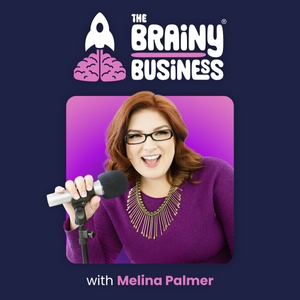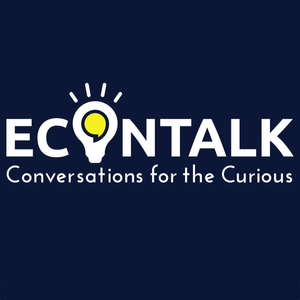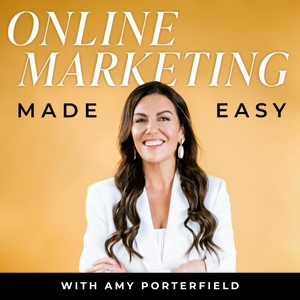
174. The Elements of Choice, with Dr. Eric J. Johnson
10/15/21 • 50 min
1 Listener
A few months ago, in episode 162 you got to hear from Leidy Klotz about his fantastic new book Subtract, which is based on this question of why we humans look to add first when often subtracting can be a better option. It is a little bit of minimalism/essentialism and a really great episode to help people overcome loss aversion and see that, as he says, “less is not a loss,” such a cool insight.
Anyway, while he and I were doing our pre and post-interview chat, he mentioned that his friend and colleague Eric Johnson had a book coming out soon called The Elements of Choice and that I should talk with him about it, so here we are. Dr. Johnson is not a newbie to the space by any means, as you will hear in the interview. He has had the opportunity to work and train with some of the most notable names in the field, including Herbert Simon, Amos Tversky, as well as his friends Richard Thaler and Cass Sunstein. He is the Norman Eig Professor of Business and the Director of the Center for Decision Sciences at Columbia Business School. He has been the president of both the Society for Judgment and Decision Making and the Society for Neuroeconomics. He has decades of experience and definitely knows his stuff, which is one of the many reasons I was so honored to chat with him and share the conversation with you.
Show Notes:- [00:07] In today’s episode I’m introducing you to Dr. Eric J. Johnson, author of the brand new book, The Elements of Choice.
- [03:57] Eric shares his background and how he got into the field. His research has always been about helping people make choices and how the way we present information to them affects their choices.
- [05:40] He was fascinated with the choices he observed people making.
- [07:06] Eric shares research from a former student of his. She implemented the health records systems at a major New York hospital.
- [09:18] Memory played an important role in the doctor’s behavior in her research.
- [11:31] When you put in the time to plan the architecture upfront, the actual intention itself can be very small. Designers often have more influence than they realize.
- [12:42] He shares his research about taking different doors at the Copenhagen airport.
- [14:06] Little bits of effort at the beginning of the decision have an influence throughout the course of the decision. Choice architecture usually works by favoring one path over another.
- [16:10] If I know exactly what you want I would give you just one option, but the person making the choice knows a lot about themselves so they often know more about what they want.
- [18:10] There is a trade-off between how much you are asking of people (in terms of deciding) and how much variety you need to give them so they can find the option that is best for them.
- [20:45] Choice is not determined by myself and my preferences alone.
- [21:38] We are all designers all the time.
- [23:14] Order will have an influence depending on your medium. There are many other things as a designer to think about also.
- [24:50] Defaults are powerful. Eric and Dan Goldstein researched defaults in organ donations.
- [27:07] Not all situations are the same, so you really need to look across all the studies and understand your own situation and context.
- [28:44] Our preferences aren’t written in stone. We have many preferences. Depending on what comes to mind, I might make different choices.
- [29:36] Eric shares one of his favorite studies where they ask people about climate change and would they pay a carbon tax (or carbon offset) to fight climate change.
- [32:26] One study is not enough to actually build a science. We need to do cross studies.
- [35:16] Eric shares how choice architecture can affect COVID vaccinations.
- [38:00] Defaults work because they endow you with the option. You think less about the disadvantages.
- [39:26] The decisions of our privacy and cookies are decisions we make multiple times a day.
- [40:32] Choice architecture and designers have amazing influence. Hopefully, people will design in ways they want to be designed to.
- [41:46] Melina shares a study about trying to influence people to take the stairs instead of riding the elevator.
- [43:31] Defaults are everywhere. They save us effort by not having to make a decision every time.
- [46:16] Melina shares her closing thoughts.
- [47:44] The more you know about someone, the fewer choices you can provide to them. When you have no idea who your customer is – what they like, what the context is of them finding you, why they are there, what needs they are looking to fill or problems they need to solve, you then have to present a whole bunch of choices, which can make it harder for them to make a decision.
- [50:33] Melina’s award-winnin...
A few months ago, in episode 162 you got to hear from Leidy Klotz about his fantastic new book Subtract, which is based on this question of why we humans look to add first when often subtracting can be a better option. It is a little bit of minimalism/essentialism and a really great episode to help people overcome loss aversion and see that, as he says, “less is not a loss,” such a cool insight.
Anyway, while he and I were doing our pre and post-interview chat, he mentioned that his friend and colleague Eric Johnson had a book coming out soon called The Elements of Choice and that I should talk with him about it, so here we are. Dr. Johnson is not a newbie to the space by any means, as you will hear in the interview. He has had the opportunity to work and train with some of the most notable names in the field, including Herbert Simon, Amos Tversky, as well as his friends Richard Thaler and Cass Sunstein. He is the Norman Eig Professor of Business and the Director of the Center for Decision Sciences at Columbia Business School. He has been the president of both the Society for Judgment and Decision Making and the Society for Neuroeconomics. He has decades of experience and definitely knows his stuff, which is one of the many reasons I was so honored to chat with him and share the conversation with you.
Show Notes:- [00:07] In today’s episode I’m introducing you to Dr. Eric J. Johnson, author of the brand new book, The Elements of Choice.
- [03:57] Eric shares his background and how he got into the field. His research has always been about helping people make choices and how the way we present information to them affects their choices.
- [05:40] He was fascinated with the choices he observed people making.
- [07:06] Eric shares research from a former student of his. She implemented the health records systems at a major New York hospital.
- [09:18] Memory played an important role in the doctor’s behavior in her research.
- [11:31] When you put in the time to plan the architecture upfront, the actual intention itself can be very small. Designers often have more influence than they realize.
- [12:42] He shares his research about taking different doors at the Copenhagen airport.
- [14:06] Little bits of effort at the beginning of the decision have an influence throughout the course of the decision. Choice architecture usually works by favoring one path over another.
- [16:10] If I know exactly what you want I would give you just one option, but the person making the choice knows a lot about themselves so they often know more about what they want.
- [18:10] There is a trade-off between how much you are asking of people (in terms of deciding) and how much variety you need to give them so they can find the option that is best for them.
- [20:45] Choice is not determined by myself and my preferences alone.
- [21:38] We are all designers all the time.
- [23:14] Order will have an influence depending on your medium. There are many other things as a designer to think about also.
- [24:50] Defaults are powerful. Eric and Dan Goldstein researched defaults in organ donations.
- [27:07] Not all situations are the same, so you really need to look across all the studies and understand your own situation and context.
- [28:44] Our preferences aren’t written in stone. We have many preferences. Depending on what comes to mind, I might make different choices.
- [29:36] Eric shares one of his favorite studies where they ask people about climate change and would they pay a carbon tax (or carbon offset) to fight climate change.
- [32:26] One study is not enough to actually build a science. We need to do cross studies.
- [35:16] Eric shares how choice architecture can affect COVID vaccinations.
- [38:00] Defaults work because they endow you with the option. You think less about the disadvantages.
- [39:26] The decisions of our privacy and cookies are decisions we make multiple times a day.
- [40:32] Choice architecture and designers have amazing influence. Hopefully, people will design in ways they want to be designed to.
- [41:46] Melina shares a study about trying to influence people to take the stairs instead of riding the elevator.
- [43:31] Defaults are everywhere. They save us effort by not having to make a decision every time.
- [46:16] Melina shares her closing thoughts.
- [47:44] The more you know about someone, the fewer choices you can provide to them. When you have no idea who your customer is – what they like, what the context is of them finding you, why they are there, what needs they are looking to fill or problems they need to solve, you then have to present a whole bunch of choices, which can make it harder for them to make a decision.
- [50:33] Melina’s award-winnin...
Previous Episode

173. The Science of Opinions, with Dr. Andy Luttrell
Today, I am very excited to introduce you to Dr. Andy Luttrell, a social psychologist who has (at least so far) devoted his career to understanding people’s opinions. You know I love a good question, and he is mostly curious about those opinions people hold onto really tightly and can’t seem to let go of. As he asks on his website, “Why do we hold some views that define us and others that we’re happy to change?”
Such an interesting topic, and I am excited to let you hear some of his findings on the science of opinions and how that ties in with persuasion in our conversation today.
Show Notes:- [00:06] In today’s episode I’m excited to introduce you to Dr. Andy Luttrell, professor and host of the Opinion Science Podcast.
- [03:15] Andy, a social psychologist, shares about himself and his background.
- [05:45] In some cultures, our view of ourselves is ever changing. Others are more fixed.
- [08:17] Your audience is going to have its own way that it prefers to navigate certain questions. The way you present yourself and your brand image, or the messages you communicate with ought to take that audience’s preference into account.
- [09:56] Oftentimes, we have to pick what works for our brand and just go with it.
- [10:41] If someone sees their stance as rooted in morality, they are often not going to budge.
- [11:18] If the message matches the kind of opinion the audience already has, it is going to go further.
- [12:49] When we are trying to talk about these moral issues, sometimes we feel like we want to retreat from talking about morals, but that is exactly the dimension that the audience cares about (and has proven to be more persuasive).
- [14:54] Are logical arguments the most persuasive or are emotional arguments the most persuasive? It depends on who you are talking to.
- [15:56] Most people are not only logical or emotional people. It also depends on the context of what you are talking about.
- [17:20] There are all sorts of ways personality variables can come into play with the persuasion process.
- [18:34] Anyone has the potential to change their mind. Some personality variables can have to do with one's willingness to engage with certain ideas.
- [20:20] Some research shows that we can sell our products or ideas framed in terms of the personality traits that define you best and that is going to have more leverage.
- [21:34] The personality of the person you are trying to influence is going to determine which message is going to be most impactful.
- [23:29] If we are framing something in terms of a very political audience and the wrong person comes across it, that might actually tarnish the image or backfire. If you are working in a sensitive space, be aware.
- [25:45] We have this foundational understanding of persuasion that goes back to the 40’s.
- [26:07] Persuasion is at the heart of what we do every day. It doesn’t feel like we are trying to constantly influence the people around us, but we are talking about our opinions almost all the time.
- [27:06] There are always going to be some growing pains in the application process.
- [29:09] We can have good guesses but we don’t have specificity.
- [31:10] If you run the same simulation a dozen times it is not going to go exactly the same in each one. There is a bunch of stuff you can never really account for.
- [32:26] You run the risk of chasing things that are not relevant if you have too much to account for.
- [33:40] Persuasion is about changing your evaluation of something.
- [35:14] A strong opinion is one that people say they will not change and it will be the thing that guides the decisions they make.
- [37:22] One place confidence comes from is consensus. If we think most people hold the same opinion, we become confident in it (for better or worse).
- [39:46] Strength is an important part of the equation in getting people from one side to another.
- [40:19] One interesting way people have looked at persuasion is through self affirmation.
- [41:29] You are perfect with room for improvement.
- [43:27] Melina shares her closing thoughts.
- [45:13] Melina’s award-winning first book, What Your Customer Wants and Can’t Tell You is available on Amazon, Bookshop, Barnes & Noble, Book Depository, and Booktopia.
Thanks for listening. Don’t forget to subscribe on Apple Podcasts or Android. If you like...
Next Episode

175. How to Avoid Disasters When Returning to the Office, with Dr. Gleb Tsipursky
Back on episode 111, I was joined by Dr. Gleb Tsipursky, CEO of Disaster Avoidance Experts discussing his book “Never Go With Your Gut.” When Gleb reached out to let me know that he has a new book on helping companies think through and prepare for returning to the office, including the cognitive biases that can impact this decision-making process for people in business, I knew I had to have him back for another conversation.
This specific topic is incredibly relevant right now, but there is also an incredible amount of insight Gleb provides about leadership’s collective cognitive biases that absolutely relate to other big strategic decisions as well. As you’ll hear in the conversation today, beyond his background knowledge of behavioral science and those concepts, Gleb interviewed and has done work with more than a dozen companies and helped them with their plans to return to the office. His insights can help you to learn from their mistakes and best practices as you work on your own plan. Whether you are looking to keep a fully remote workforce, have everyone back in the office, a hybrid approach, or if you aren’t sure yet, this episode is for you.
Show Notes:- [00:07] In today’s episode I’m delighted to have Dr. Gleb Tsipursky back with us to share about how to avoid disasters when returning to the office.
- [01:45] His insights can help you to learn from their mistakes and best practices as you work on your own plan.
- [03:40] Gleb shares about himself and his background. His background is in decision-making and risk management.
- [06:02] Most recently he has been helping companies return to the office most effectively and prepare for the future of work.
- [08:37] People are your main source of competitive advantage. What do your current people want? What do your potential hires want?
- [10:34] If your people are your main source of competitive advantage, wouldn’t you think you would want to know what kind of things they want to do in returning to the office? It is their future after all.
- [11:12] The surveys tell us that the future is very much hybrid: 85% of people in various surveys want a hybrid or full-time remote option.
- [14:13] People report higher productivity as well as much higher happiness and well-being when they are working from home.
- [16:08] There are a lot of advantages to having substantial remote work and disadvantages to forcing people back into the office.
- [17:28] Your primary consideration should be your people. Then you can look at how many usages you are having of your location.
- [20:14] Once you decide on occupancy, you can get rid of some of your unused space.
- [21:25] You need to transform much of your existing space into a collaborative space.
- [22:52] Status quo bias is one of the biggest problems here. The status quo bias refers to the fact that we prefer things to remain stable, as they were, and the right way.
- [24:20] Never go with your gut (learn more about this in Gleb’s book of the same name, link below).
- [26:21] Another related bias to this problem is anchoring. We tend to be anchored to the initial information that we have.
- [28:08] Confirmation bias is one of the biggest problems that we have in terms of the information we gather.
- [30:50] You want to make sure to plan for the possibilities of other variants down the road.
- [32:26] You want to strategically adapt to the virtual format.
- [35:38] Two dynamics for creating serendipitous conversions in virtual settings are innovation and collaboration.
- [37:40] Companies need to have a channel for serendipitous idea generation for each team. Then other people see the comment and then they comment back and then that transforms into a really great conversation that you can take into brainstorming.
- [39:48] Traditional brainstorming has a number of advantages and some problems.
- [41:31] It helps to have virtual brainstorming instead. Virtual brainstorming involves people separately typing into a digital spreadsheet anonymously.
- [43:30] This has been shown to greatly improve the number and quality of ideas generated.
- [44:51] How can we make this something amazing versus something we are stuck with?
- [46:42] When you are able to look at the opportunity, you are able to beat out your competitors.
- [47:58] We can actually successfully work remotely. It is a fundamental transition in how we think and approach the world.
- [49:18] You need to adopt best practices for hybrid and remote settings.
- [50:52] Melina shares her closing thoughts.
- [53:50] The important thing to keep in mind, much like Gleb’s advice for recreating serendipitous moments online or doing virtual brainstorming, is that you can’t allow yourself to be stuck by the constrain...
If you like this episode you’ll love
Episode Comments
Generate a badge
Get a badge for your website that links back to this episode
<a href="https://goodpods.com/podcasts/the-brainy-business-understanding-the-psychology-of-why-people-buy-beh-136281/174-the-elements-of-choice-with-dr-eric-j-johnson-17017935"> <img src="https://storage.googleapis.com/goodpods-images-bucket/badges/generic-badge-1.svg" alt="listen to 174. the elements of choice, with dr. eric j. johnson on goodpods" style="width: 225px" /> </a>
Copy




